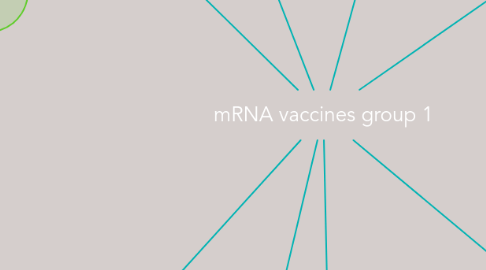
1. Advantages of mRNA vaccines
1.1. Doesn't require scientists to grow the virus in the lab, eliminating the need to generate a large amount of the virus or viral particles for the vaccine
1.2. mRNA vaccines are not infectious therefore they cannot give you the disease they are protecting against
1.3. Have a very low risk of causing an unwanted immune response
2. mRNA vaccine candidates
2.1. Moderna candidate mRNA-1273
2.1.1. lipid-nanoparticle encapsulated, nucleoside modified mRNA-based vaccine that encodes for SARS-CoV-2 spike (S) glycoprotein stabilized in its prefusion conformation
2.1.2. S glycoprotein is responsible for host cell attachment and is required for viral entry
2.1.3. encodes the S-2P antigen consisting of the SARS-CoV-2 glycoprotein with a transmembrane anchor and an intact S1-S2 cleavage site
2.1.3.1. clinical trial: -2-doses separated by 28 days -follow up visits every 7 days -injection in deltoid
2.1.3.1.1. No serious adverse events were noted.
2.1.3.1.2. SARS-CoV-2 binding antibody responses increased rapidly after first vaccination, with seroconversion in all participants by day 15. This response was found to be dose-dependent.
2.1.3.1.3. Promising results!
2.2. Pfizer and BioNTech candidate BNT162b2
2.2.1. make human cells grow an antigen of SARS-CoV-2, known as the "spike protein," on their surface. The immune system sees these spike proteins and develops infection-fighting "antibodies" against it, without ever exposing it to the actual virus.
2.2.1.1. Clinical trials examining: - 2-dose separated by 21 days - various dose levels - 3 age groups: ≥12, 18-55, 65-85 - intramuscular injection
2.2.1.1.1. Who can participate? - Participants who are willing and able to comply with all scheduled visits, vaccination plan, laboratory tests, lifestyle considerations, and other study procedures - Healthy participants who are determined by medical history, physical examination, and clinical judgment of the investigator to be eligible for inclusion in the study - Participants at risk for acquiring COVID-19 - Participants capable of giving personal signed informed consent *Note: many exclusions
2.2.1.2. When will it be available? Although vaccines generally take 10-15 years to develop, Pfizer states they will have it on the market by the end of 2020
2.2.1.3. Reactions reported: - Pain at the injection site, redness, and swelling 7 days after dose 1 and 2 - Fever, fatigue, headache, chills, vomiting, diarrhea, new or worsened muscle pain, and new or worsened joint pain *No serious safety concerns reported
2.2.1.3.1. Efficacy rate: above 90%, at 7 days after the second dose
3. Side effects reported of mRNA vaccines
3.1. High reported incidence of arm pain, soreness and fever.
3.2. Other common side effects are fatigue, joint pain and headache.
3.3. All described as generally short-lived and well-tolerated.
4. Challenges of mRNA vaccines
4.1. the mRNA strand in the vaccine may elicit an unintended immune reaction
4.2. delivering the vaccine effectively to cells is challenging since free RNA in the body is quickly broken down - to help achieve delivery, the RNA strand is incorporated into a larger molecule or packaged into particles or liposomes
4.3. many need to be frozen or refrigerated
5. What is mRNA?
5.1. mRNA (messenger RNA) is the genetic information that contains instructions for making proteins. It is read by ribosomes and uses tRNA and amino acids to form proteins (process of translation)
6. How do mRNA vaccines work?
6.1. When given the vaccine, the mRNA causes the production of virus antigens (identifying proteins) by immune cells, these antigens are recognized by the immune system and antibodies are created to fight off the pathogens
6.1.1. How is this beneficial?
6.1.1.1. When you get infected it takes longer to develop an immune response because the immune cells have to find the virus, process it and then present the antigens to generate antibodies. Producing the antigens by the immune cell ribosomes allows for a faster response
7. Synthetic mRNA
7.1. Function
7.1.1. Used to deliver desired gene transcriptions to induce protein expression. The introduced mRNA is translated under physiological conditions by the cellular translation machinery. Due to lack of integration into the host cell genome compared to viral gene therapy vectors, the risk of oncogenesis is prevented.
7.2. The mRNA production process
7.2.1. Coding DNA sequences are amplified by PCR using specific primers. The mRNA is generated from DNA product using the in vitro transcription process. The product is purified and treated with phosphatase to remove 5'-triphosphates. After the additional purification and quality control of generated mRNA, the mRNA transfections can be performed.
